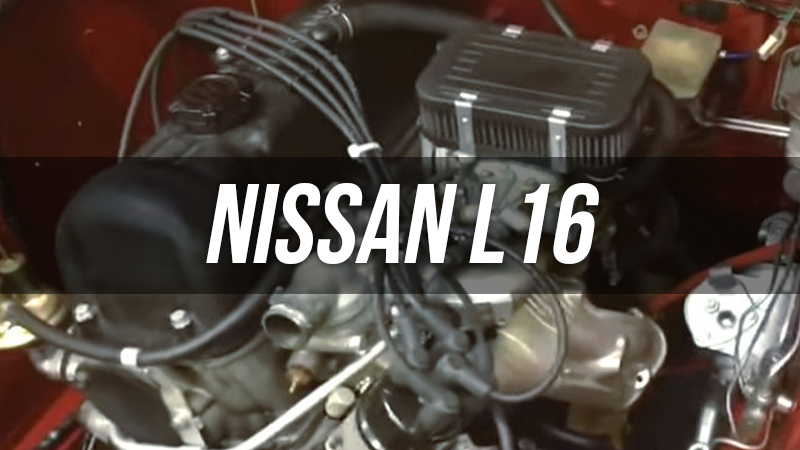From 1967 through 1986, Nissan L series vehicle engines were built in both inline-four and inline-six designs with displacements ranging from 1.3 L to 2.8 L. This was the engine that powered the Datsun 510, 240Z sports vehicle, and Nissan Maxima.
It is a two-valve per cylinder SOHC non-crossflow engine with an iron block and an aluminum head. It is recognized for its dependability, durability, and parts interchangeability. The four-cylinder L series engines were replaced by the Z series and then by the CA series, while the six-cylinder L series engines were replaced by the VG and RB series.
The L16 four-cylinder design was influenced by the Mercedes-Benz M180 engine, which the Prince Motor Company developed as the Prince G engine in four- and six-cylinder displacements.
What are Nissan L16 Engines?
The L16 is a 1.6 L inline-four engine with a 2-barrel Hitachi-SU carburetor that was developed for the Datsun 510 from 1967 to 1973. Through 1971, it produced 96 horsepower at 6000 rpm and maximum torque of 100 lb-ft at 3600 rpm, then 92 hp. The bore and stroke measurements are 83 mm and 73.7 mm, respectively. The Prince G-16 was succeeded by the L16.
The Nissan (Datsun) L16 engine produces smooth, steady power thanks to OHC valves, a wedge-shaped combustion chamber, an aluminum cylinder head, and a completely balanced five-bearing crankshaft. The cylinder block is cast as a single piece with substantial skirting. The engine has a single, two-barrel, downdraft carburetor.
There was also an L16 engine with an SU dual carburetor. This engine, known as the L16T, had flat top pistons, a slightly modified head, a higher compression ratio rating, and more power and torque.
Engine Specifications and Design:
- Production Run: 2016 – Present
- Cylinder Head Material: Aluminum
- Cylinder Block Material: Cast-iron
- Configuration: Inline 4
- Bore: 83.0 mm
- Stroke: 73.7 mm
- Valvetrain: DOHC four valves per cylinder
- Displacement: 1.6 L (1595 cc)
- Compression Ratio: 8.5
- Weight: Unknown
- Maximum HP: 96 HP at 6,000 RPM
- Maximum Torque: 100 lb-ft at 6,000 RPM
Cylinder Block
The cylinder block of the Nissan L16 engine is made of cast iron. The five-bearing-support system is used in the cylinder block, which has a monoblock unique casting construction.
Cooling jackets surround the cylinder bores, which are machined directly in the block. The oilways in the block are configured so that the full-flow oil filter is immediately coupled to the block’s right side.
The crankshaft is forged from unique steel. It produces smooth, steady power at high speeds when fully balanced. Oil injected via the main oil gallery and the oil holes that run parallel to the cylinder bores lubricate the main bearings.
The pistons are made of a unique aluminum alloy and feature two compression rings and one combined oil ring to limit thermal expansion. The piston pin is a hollow steel shaft with a specific shape. It is press-fit to the connecting rods and fully floating to the piston. The connecting rods are made of forged special steel.
Cylinder Head
Nissan’s L16 engine cylinder head is comprised of a lightweight and sturdy aluminum alloy with high cooling efficiency, and it has wedge-type combustion chambers. The intake valve has a specific aluminum bronze valve seat, while the exhaust valve has a heat-resistant steel valve seat. All of these components are hot press-fitted.
In addition to that, the camshaft is composed of unique cast iron and is housed under the rocker cover; the camshaft is supported by four aluminum alloy brackets. The camshaft bearings are lubricated via oil holes that feed to the cylinder head’s primary oil gallery. The cam mechanism directly activates a pivot-type rocker arm in the valve system.
The dual-type valve springs are used in the Nissan L16 engine.
A double row roller chain powered by the crankshaft drives the camshaft. A chain tensioner, which is actuated by a spring and oil pressure, controls the tension of the chain.
Applications of Nissan L16 Engine:
- 1968 – 1973 Datsun 510
- 1970 – 1972 Datsun 521 pick-up
- 1972 – 1973 Datsun 620 pick-up
- 1971 – 1977 Nissan 160B sedan 610
- 1977 – 1978 Nissan Violet/Auster/Stanza/160J (A10)
- 1973 – 1977 Nissan Violet/Datsun 160J (P710/P711)
Problems Surrounding Nissan L16 Engine:
There’s no denying that the Nissan L16 is an old engine now if we are talking about the age since its actual production. It has a pretty loaded age on its back, so the problems and issues we will be addressing are mainly due to the age of the engine.
1. Crankcase Ventilation Issues
There are reports from some owners that the crankcase ventilation tube pops out after the engine begins to idle and eventually dies out after a few minutes. Some of its manifestations include intermittent engine breakdown and engine dying out.
It can also be caused by a bad ignition.
2. Valve Cover Gasket Leaks
The oil is spilling from the valve cover vent hose. Because you have a Weber, it should be linked to the air filter. The block vent pipe or the hose connecting it to the PCV valve is broken or missing, and oil is leaking onto the header.
Summary
The Nissan L16 engine, despite its old age, is still a pretty solid engine. Most of the enthusiasts still have a deep inclination to these 60s engines as they are made for a wide range of applications. Though it is hard now to find these engines, many still look for them.
With its solid build and nasty performance, a great engine of its own to show itself even in the 60s and 70s.
The vintage and overall montage of the engine adds a striking feature making it one of the wholesome engines these days, even at its long history of production.
Disclosure: As an Amazon Associate, I earn from qualifying purchases made through links on this website.
